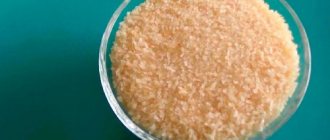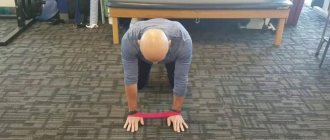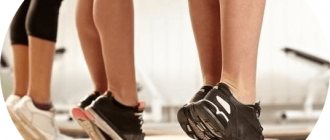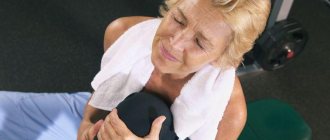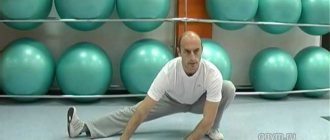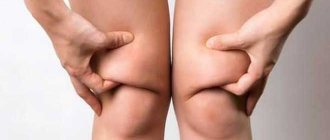Every athlete sooner or later faces a task: how to strengthen ligaments and tendons? On the one hand, weakness of the tendon-ligamentous apparatus begins to interfere with achieving maximum speed-strength results. On the other hand, the tendons, not having time to recover between extreme loads, first begin to cause discomfort, and then become completely injured, canceling out all training progress. So how to strengthen ligaments?
Principles of strengthening ligaments and joints
Ligaments are dense formations of connective tissue that connect bones and support internal organs. Most ligaments are localized around large joints, their main function is to strengthen the joints of bones, guide and limit movements. The elastic ligamentous apparatus provides joint flexibility and prevents dislocations and sprains.
Ligament relaxation occurs for various reasons. For some, connective tissue weakness is congenital. In other cases, the ligamentous apparatus loses its natural functions as a result of improper loads or with age.
It is quite possible to strengthen weak joint ligaments, and this can be done at home.
Properly selected nutrition, daily dosed loads on large joints and a course of dietary supplements will allow you not to experience any special problems with the musculoskeletal system in old age.
Why do you need to strengthen ligaments?
A weak ligamentous apparatus causes most joint problems of a traumatic and degenerative nature. With weakened ligaments, injury, direct blow or careless movement lead to serious damage that requires long-term treatment and even surgery. In addition, ligaments are responsible for the stability of the joint, if violated, degeneration processes progress, which becomes the cause of arthrosis.
Therefore, ligament weakness causes:
- fractures;
- sprains and ruptures of tendons and ligaments;
- meniscus damage;
- arthrosis and bursitis;
- joint instability.
It is important to strengthen the joint without causing serious consequences. Various pathologies and conditions lead to weakening of ligamentous tissues.
Doctors recommend special programs to strengthen the joint:
- for diseases such as arthrosis, arthritis, bursitis;
- after joint surgery;
- if you are overweight;
- after surgery to restore ligaments;
- with joint instability;
- after injury;
- with prolonged absence of adequate loads on the joint;
- after removing the plaster.
Doctors recommend the following as effective treatment methods that help strengthen the joint:
- lifestyle correction;
- special food;
- physical exercise.
You can supplement therapy with treatment in a sanatorium, which provides special programs for joint restoration.
Nutrition that strengthens ligaments and joints
The load on the ligamentous apparatus and the deterioration of its blood supply increase many times over if a person is overweight. Therefore, a diet to strengthen ligaments should first of all be selected so that body weight is normalized. Improving metabolic processes in the tissues of the musculoskeletal system is of no small importance.
To improve the elasticity of the ligamentous-muscular system, it is necessary that the diet include certain microelements. The condition of connective tissue improves if the diet contains natural collagen, calcium, sulfur, magnesium, vitamins E, C, D, and niacin.
Collagen is the main protein of connective tissue fibers. With its deficiency in the body, the strength and flexibility of ligaments and joint membranes decreases. Rich in collagen:
- Aspic.
- Meat broth on bones.
- Lean, fibrous meat.
- Jelly.
- Jellied from different varieties of fish.
- Legumes.
Ligaments and tendons become stronger, and the cartilage tissue of joints is strengthened if foods rich in selenium and sulfur are present in the diet:
- Sea fish.
- Beef and chicken meat.
- Chicken eggs.
- Seafood - mussels, shrimp.
- Kelp.
- Among vegetables, cabbage, radishes and onions are especially useful.
- Cereals.
To strengthen and restore ligaments, it is necessary that omega fatty acids are constantly present in the diet. There are many of them in fatty fish and vegetable oils. It is imperative to include lactic acid products in your daily diet; they contain a lot of calcium needed by the musculoskeletal system. Moreover, you need to take into account that low-fat dairy products strengthen ligaments and bones better.
Vitamin E is found in nuts, dried apricots and greens. Ascorbic acid is found in many plant foods. To ensure the supply of all the nutrients necessary for ligaments and joints, it is necessary that the daily diet be as varied as possible. Do not forget about maintaining a drinking regime.
Metabolic reactions proceed normally only if at least one and a half liters of liquids are drunk per day.
A diet that includes the most necessary products for the ligamentous apparatus will be ineffective if “harmful” types of food are not excluded from the diet:
- Phosphorus-containing products - sausages, smoked meats, soda, premium bread, processed cheese. Excessive consumption of these products interferes with the absorption of calcium, it is washed out of the bone tissue, and as a result, osteoporosis develops.
- Beer, chocolate, coffee, strong tea. The uric acid they contain can accumulate in the joint capsule, which leads to the development of a specific inflammatory process - gout.
- Sorrel. Irritates peripheral nerve fibers, which can impair the transmission of impulses through the muscular-ligamentous apparatus.
Products for bundles will bring maximum benefit if you steam, boil or bake them.
Knee health
Throughout life, knees are subject to enormous stress. Their joints constantly support the weight of the body, and also suffer from household and sports injuries. The knee is the largest and most complex joint in the human body ; many muscles, ligaments and tendons are involved in its work, the coherence of which ensures the stability of the knee and the function of the leg.
The bones of the lower body are greatly affected by gravity, and when simply walking, a person's knees are subjected to a force that is 4-5 times their weight. And during sports, when your feet hit the ground, this force can exceed your body weight by more than 12 times. Therefore, excess weight sharply increases the risk of knee injuries and is the root cause of half of all operations to restore articular knee cartilage.
The role of ligaments
The knee joint has cruciate and collateral ligaments . These are ligaments that strengthen the joint. Fibrous interosseous ligaments, which strengthen the knee joint, also control movement in it. They can pass inside its cavity, in the walls of the joint capsule and outside it. These strong bands of connective tissue connect the articulated bones and are essential to their strength, as a healthy ligament can stretch up to 5% of its original length.
Further stretching threatens injury, sprain. This is the appearance of micro-tears inside the tissue, leading to pain and swelling of the joint, as well as a decrease in its maneuverability. Under increased loads, especially in sports, ligaments can be torn; such an injury is possible even if you fall. This causes pain and swelling, and the stability of the knee decreases.
Complexes of physical exercises
You can strengthen the ligaments and joints with the help of daily static exercises, that is, those in which the muscles are tense, but the amplitude of their movements is insignificant. Additionally, it is recommended to use light weights during training.
When performing exercises, gradualness is important. You should not try to perform all the elements at once; the weight of dumbbells should also be minimal in the first days. Gymnastics begins with a light warm-up - walking in place, swinging your arms, turning to the side, bending. Ideally, it is necessary to select a complex for skeletal flexibility, the implementation of which will allow you to work out the entire muscular-ligamentous apparatus of the body.
Shoulder joint
- Push-ups. The exercise not only strengthens the ligaments of the shoulder joint and chest, but also increases the endurance of the spine. You need to lie on your stomach, place your palms down, shoulder-width apart, rest your toes on the floor, and straighten your back. When performing the exercise, you need to straighten up with outstretched arms and smoothly lower down. For starters, 2-3 push-ups are enough, then the number of repetitions can be increased to 10.
- Swing your arms with dumbbells. You need to take weights in both hands, weighing no more than two kilograms each. Stretch your arms forward and swing them, range of motion – up to 14 degrees. Proper training leads to a burning sensation in the muscles; swings are performed until the arms refuse to move.
Knee-joint
Strengthening the ligaments of the knee joint will reduce the likelihood of sprains, fractures and damage to the meniscus. The most effective way to increase the elasticity and strength of the cruciate ligaments of the knee is through stretching exercises. Exercises with a load on the knee joint are performed while standing; it is recommended not to start exercising with them after injuries to this area, operations, or for people without physical training. Without load, gymnastics is performed from a lying position.
After a ligament rupture, exercises that are easy to perform and do not cause discomfort are first selected to develop them. If pain appears during exercise, then they are temporarily postponed and a complex of physical therapy exercises is practiced that does not cause pain.
The knees should be prepared to strengthen the ligaments; they help with this:
- Swinging your leg back and forth from a sitting position on a chair.
- Slips. You need to lie on your back, bend your knees and slide your feet along the floor.
- Extension and flexion. From a position lying on your side, you need to bend and straighten your upper limb at the knee joint.
- Stretching. Sit on the floor and try to reach your feet with your back straight.
After warming up, move on to the main exercises:
- Squat. The exercise should be performed so that the thighs become parallel to the floor. You need to hold this position for a few seconds and then smoothly straighten up.
- From a standing position, take a wide step to the side with one leg, immediately sit down, place the other limb and slowly stand up.
- Jumping. You can train with a jump rope; the load on your knees is reduced if you land on slightly bent legs.
Strengthening the knee joint is facilitated by increased elasticity of the popliteal ligaments.
Their simplest training is walking up the stairs.
Hip joint
- Stand up straight. Spread your legs shoulder-width apart, place your palms on your waist. The torso must be turned to the sides as deeply as possible, but the feet should not come off the surface.
- Lie on your back. The leg must be bent so that its thigh part is vertical, and the lower part, up to the shin, takes a horizontal position. Then you need to carefully straighten the leg, grab the shin and pull the limb towards you. After this, the leg bends again and straightens down to the floor.
- Sit on the floor with your knees bent. Place an elastic ball between your knees and press it, trying to hold it for up to 15 seconds. The exercise is performed 10-15 times.
Ankle joint
Sprains and dislocations most often occur in the ankle joint. Easy-to-do exercises will help strengthen your ligaments.
It is necessary to constantly practice walking on your toes, the outer and inner sides of the foot; naturally, at first it is better to do this without haste at home. Strengthening the muscular-ligamentous system is facilitated by rotating the feet in different directions, walking barefoot on sand and pebbles.
Of the special exercises, orthopedists often recommend the following:
- Rolling a water bottle on the floor with your feet.
- Picking up small objects with bent toes.
- Jumping rope.
You can also use an elastic rubber band for exercise. One end of it is strengthened on a strong support, and the foot is threaded into the free part. After this, you need to stretch the tape and pull your foot towards you.
Elbow joint
Swinging to the sides, forward and backward with straightened upper limbs helps in strengthening the ligaments of the elbow joint. To increase the load, you can use a rubber band. Its middle part is pressed to the floor with your feet, the ends are taken in your hands and exercises are performed.
You can also increase the strength of the ligaments in your elbow by training your biceps. Dumbbells of 1-2 kg are used as weighting material. Swings should be performed in such a way that only part of the arm up to the elbow moves.
Joints of the hand
The joints of the hands can be trained using expanders and wrist simulators. Squeezing and unclenching them for just 10-15 minutes a day reduces the load on the muscular-ligamentous system, increases its endurance, and improves metabolic reactions.
To train the wrist joints, hanging on a horizontal bar with all fingers fully covering the bar is suitable. You can do this exercise every day - place your palms on the table, raise your fingers up and try to hold them in this position for as long as possible. Improving the flexibility of the wrist and small joints of the fingers is facilitated by rotating the hands clenched into a fist in different directions.
Basic exercises to strengthen the ligaments of the shoulder and knee joints
Medical restoration of joints and ligaments
For joint injuries and sprains, the doctor prescribes special treatment for his patient, including the use of non-steroidal anti-inflammatory drugs. These drugs help reduce inflammation, reduce pain and shorten the time it takes to restore lost functions. For preventive purposes, you can take courses of vitamins to strengthen the muscular-ligamentous system. When choosing vitamin and mineral supplements, you need to choose those that contain:
- Vitamin A. Helps improve metabolic functions.
- Vitamin C and E. Strengthen the immune system and protect joint tissue.
- Selenium and sulfur. Improves the condition of cartilage.
- Calcium and vitamin D. Strengthen bone tissue.
After 50 years, it is useful to take courses of chondroprotective drugs. Under their influence, ligaments and joints are strengthened, and degenerative-dystrophic processes in the entire musculoskeletal system are prevented.
Folk remedies
Strengthening the ligamentous apparatus at home is very accessible and simple. These recipes are inexpensive, easy to make and practically safe and harmless to other organs and systems, and therefore they can also be used as preventive measures.
Egg shell based composition
Ground eggshells, lemon juice and honey are mixed in equal proportions. Every day you need to take 1-2 tsp. of this composition between meals. The course of treatment is 4 weeks.
Herbal infusion
Dried leaves of St. John's wort, dill and parsley are mixed in equal parts. Now pour half a glass of the dry mixture with a glass of boiling water and cover with a thick towel. It is necessary to insist for 3 hours and then strain. This drink is divided into 3 doses and drunk throughout the day.
Honey with carrot juice
These products must be mixed in equal quantities. You should take 2 tbsp. l. morning and evening an hour before meals. This composition enriches the body with almost all vitamins and minerals, including the rarest ones. Honey is rich in biologically active substances that trigger the process of activating the immune system. There is only one exception to this recipe - allergic consequences of taking bee products.
Juice combined with honey is an effective recipe for strengthening joints and ligaments
When is it necessary to consult a doctor?
Professional help from qualified doctors is needed by people who have sprains and dislocations that recur periodically. You should definitely consult a doctor after joint injury, inflammation, swelling, pain. A number of diseases of the muscular-ligamentous apparatus and bone joints are treated with specific medications and special exercise therapy; only a competent specialist can select them.
Strengthening ligaments must be done from a very young age. Daily exercises, dosed physical activity, balanced nutrition and reducing the risk of injury have a positive effect not only on the condition of the joints and ligaments, but also on the entire body as a whole.
What is the key to healthy joints and ligaments?
Movement
Strengthening joints and ligaments is impossible without including sports in your life. But here too there are rules and requirements. It is preferable to choose static rather than dynamic exercises. This means that the most effective exercises in this regard will be those exercises in which muscle tension occurs, and the joints themselves are in an almost stationary position, that is, the amplitude of movements is very small.
Gradualism. This means that you cannot immediately choose the heaviest exercises. To begin with, those types that provide a minimal but sufficient load on the joints and ligaments are also suitable. Gradually the complexity and frequency of their implementation can be increased. Warm up. It is imperative to start a set of exercises with it. Moreover, without warming up, gymnastics itself can cause injury, such as sprains or dislocations.
Warming up allows you to effectively warm up the joints and prepare them for the load.
Stretching at the end of your workout. It helps make the ligaments elastic and will also increase the rate of delivery of nutrients to the ligaments and bones. Regularity. Classes conducted from time to time will not bring positive results. The body will not get used to the stress, but, on the contrary, will periodically be in a state of stress. Some sports are best avoided for joint health. These include, for example, weightlifting.
Lifting heavy weights has an extremely negative impact on the condition of the hip, knee and ankle joints. Treating the consequences of improper exercise is much more difficult than preventing complications. Jumping can cause damage to the ligaments of the knee joint. Also, when jumping, at the moment of landing, there is a sharp increase in the load on the spine, which is fraught with damage.
Swimming and gymnastics in water are the best way to strengthen joints, make ligaments elastic, and muscles strong. Unlike other types of gymnastics, swimming does not require a warm-up, and when immersed in the pool, you can immediately begin active actions
What gymnastics is the safest and most beneficial for the skeleton? The most preferred sport for all joints is swimming. It effectively develops all muscle groups, and also strengthens the respiratory system, increases lung volume, as a result of which more oxygen enters the body, and oxidative and metabolic processes proceed faster.

